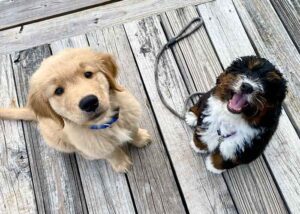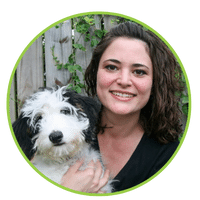Puppy Socialization Treasure Coast
Do you ever notice the dogs that can walk through a busy park and stay connected to their pet parent? They can pass by another dog without a second glance. They can walk by people without becoming overexcited or pulling. If this is the type of dog, you wish to have, read this article!
I’ve noticed a trend lately. There’s a big push for all dogs and puppies to interact and play with other dogs. The narrative is so strong that you may even feel like a crappy dog parent if your dog doesn’t have dog friends! After all, how could you deprive your dog of “socialization”?!
With this in mind, you begin to make puppy playtime a priority for your new dog. It takes precedent over establishing a good training foundation with the pup. You start letting your enthusiastic puppy greet every dog on a leash in the neighborhood in the name of socialization. You may go to a group class that encourages puppy romping and roughhousing. You may even take their puppy to a dog park (which I strongly discourage for various reasons, including disease risk).

Puppy Socialization Treasure Coast
At first, you relish your puppy’s excitement and joy when they see another dog. I mean, what’s more fun than watching puppies wrestle? But as the puppy grows, it becomes more apparent that your puppy’s excited behavior towards other dogs is problematic. He used to pull toward other dogs, but now he gets up on two legs and starts vocalizing. He’s totally forgotten that you exist and has a one-track mind. He WANTS TO GET OVER TO THAT DOG. And he thinks that the harder he pulls, and the more he whines, the sooner he can drag you over there. After all, this is what he’s (accidentally) been trained to do! He sees something he wants, he pulls towards it, and you walk him over there. He’s also learned that playing with other dogs is WAY more fun than whatever you have to offer. You soon have a teenage puppy that gets highly frustrated on the leash and is a pain in the butt to walk.
On the other hand, perhaps you have a more timid puppy. You hear from a friend that getting your pup around other dogs will fix this problem. You begin encouraging people to walk their dog up to your puppy. Or maybe you take him to an area with loose dogs running around. Your puppy attempts to hide behind you, perhaps even cries in fear when the other dogs come up to him. You don’t realize that overwhelming your puppy in social situations like this can backfire. It can make his fear worse instead of better. As your puppy ages, he learns that his passive, fearful signals aren’t being heard, so he begins to growl, bark or lunge at other dogs offensively. It often looks similar to the excited/frustrated dog I described above, but the internal motivation is different.
So how do we avoid accidentally creating these problems but still socialize our dogs?
Avoid letting your pup interact with every dog or person that crosses their path. It’s not necessary for them to physically touch every person or dog, but they still benefit from the exposure of seeing other people and dogs.
Build up your relationship with your dog. Building your relationship can be done through fun play sessions and training. I love using a tug and fetch game to keep a dog engaged with me. Play also helps nervous dogs gain confidence. If your dog thinks you’re fun, he’ll be more likely to pay attention to you in public or while walking.
Teach your dog what a clicker means by clicking and then giving a treat. Once your dog understands that the click means a treat is coming, you are ready to start using it on walks.
When out walking with your pup or dog, watch his body language and click as soon as you see him notice a dog, person, squirrel, whatever. Then quickly deliver a treat to him. Be sure to click before he pulls or vocalizes. Move farther away from the oncoming distraction if needed to prevent your dog from barking. After some practice, you’ll notice that your dog looks at a distraction but then turns back to check in with you. This is what you want! This behavior creates a dog that can walk through a busy park without making a scene!
Other passive puppy socialization ideas include:
-
-
- Take your dog on a car ride and spend about 5 minutes parked in a busy store parking lot or animal hospital parking lot. Stay in the car and click and treat your dog for watching people walk by the vehicle.
- Find a low traffic park and sit on a bench. Place a mat next to you and have your dog lie on the mat and drop treats down to them for calm behavior. When a person or dog walks by, give your dog treats quickly to keep them down and relaxed. Just make sure you don’t allow someone to step up to your dog in this situation.
- Sit in your front yard or driveway and click and reward your dog for watching people walk by.
-
The main idea here is to EXPOSE your dog to new places and things but reward them for checking in with you and being calm. Just click and treat! Do not allow them to pull you over to something they’re excited about and if they are afraid, don’t force them to interact.
This will help you create a polite dog that can pass by another dog without overexcitement or fear.
Once this behavior pattern is ingrained, you may consider teaching your confident dog to say hello on cue. But that’s a topic for a different day!
If you’d like more help with socializing your puppy contact me now for a free consultaion

